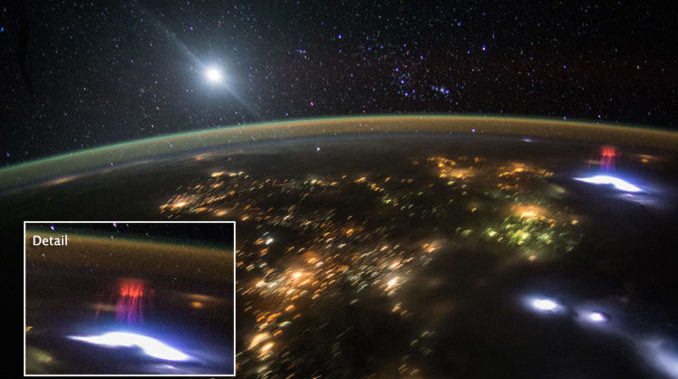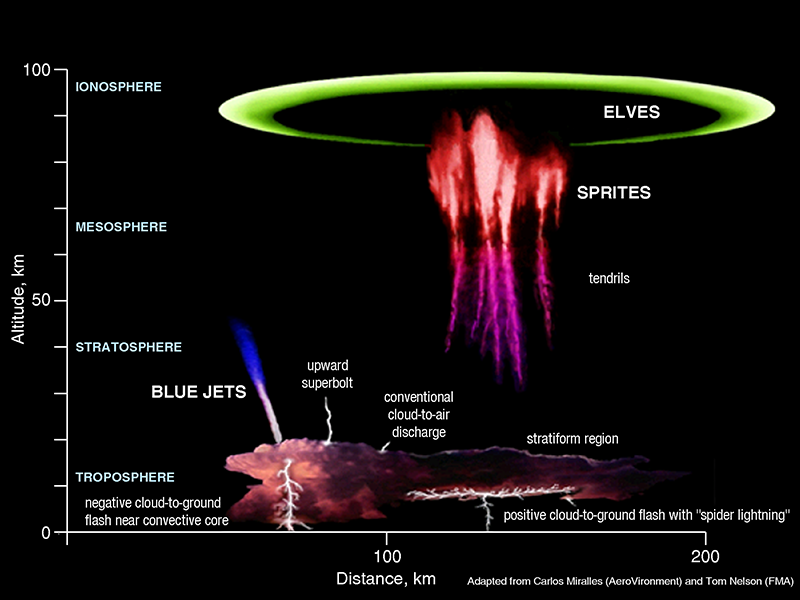
Sprites and elves were kindred supernatural spirits in folklore, often seen in bygone ages (if the stories are to be believed). Seldom seen today, they live on, high in the atmosphere above massive storms. They may be found nearly as high as the Kármán line, (the officially defined boundary between the atmosphere and space, at an altitude of 100 km, or 62 miles).
The National Severe Storms Laboratory (NSSL), appropriately headquartered in Norman, OK, describes sprites and elves as transient luminous events (TLEs) which are dim and last only a small fraction of a second. In other words, they are recently discovered forms of high-altitude lightning. (By the way, NSSL is part of NOAA, the National Oceanic and Atmospheric Administration).
Sprites, also known as red sprites, last only milliseconds and occur above large, powerful thunderstorms, and therefore are very rarely seen from the ground. Shooting from the tops of the clouds, sprites can reach upwards as much as 96.6 km (60 miles) high. Sophisticated cameras with a high sensitivity to the low levels of light produced by sprites are required to capture the phenomenon’s image.
Sprites have been photographed from the Space Shuttle and the International Space Station (ISS). In fact, it was a shuttle mission that proved sprites exist. Decades of aircraft pilot’s observations and reports of sprites were not confirmed until 1989, when instruments aboard the shuttle (STS-34) collected the necessary evidence.
The red color of sprites is attributed to the presence of nitrogen, which is the major component of Earth’s atmosphere (approximately 78% if the sample is dry air). A full-color image of a sprite, the first ever recorded, was captured in a video by the Geophysical Institute, University of Alaska Fairbanks, on July 4, 1994, from an aircraft at high altitude.
They were once so elusive that scientists gave them a mystical name. “Red sprites” are short-lived, red flashes that occur about 80 kilometers (50 miles) up in the atmosphere. With long, vertical tendrils like a jellyfish, these electrical discharges can extend 20 to 30 kilometers up into the atmosphere and are connected to thunderstorms and lightning.
earthobservatory.nasa.gov

Elves (in the meteorological sense), like sprites, are also dim expressions of electric activity. They are found at even higher altitudes than sprites, but less is known about them. Elves are round like a disk or a frisbee and can be as much as 482.8 km (300 miles) in diameter. They exist only for less than a millisecond – that’s less than one-thousandth of a second! Scientists theorize that elves are caused by high-energy electromagnetic pulses, which travel upwards from the storms below. A low-light video camera on board a space shuttle made possible the discovery of this phenomenon in 1992.
There are other types of TLEs, as well. Blue jets are another commonly observed TLE, but they occur at much lower altitude than elves and sprites.
Question of the night: When was the last time you saw an elf or a sprite?

1 Trackback / Pingback
Comments are closed.